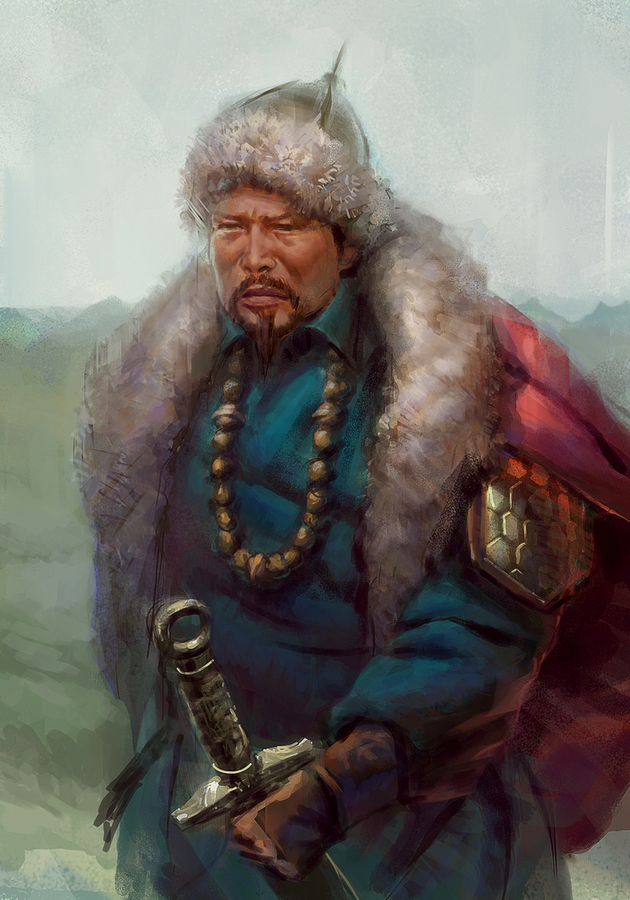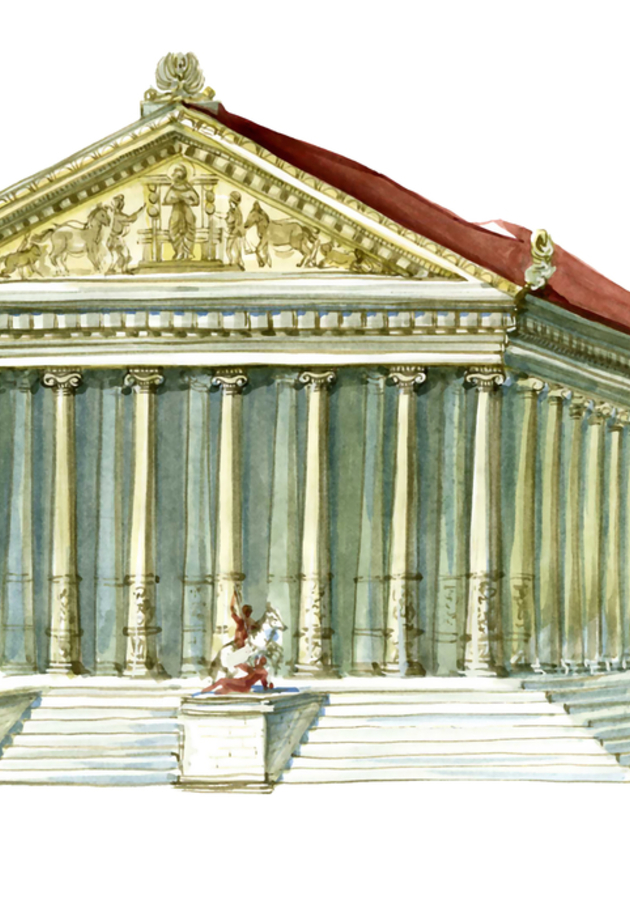Stretching from Eastern Europe to the Sea of Japan, the Mongol Empire was the largest contiguous land empire in history. And yet, the legacy of the Empire’s founder, Genghis Khan, is riddled with stories about cruelty and blood lust, and strikingly at odds with the legacies of famous European military leaders such as Alexander the Great.
“With the passage of centuries,” bemoans cultural anthropologist Jack Weatherford in his exceptional book, “Genghis Khan and the Making of the Modern World,” “scholars weighed the atrocities and aggression committed by men such as Alexander, Caesar, Charlemagne, or Napoleon against their accomplishments or their special mission in history. For Genghis Khan and the Mongols, however, their achievements lay forgotten, while their alleged crimes and brutality became magnified.” Weatherford’s book is a seemingly controversial, but ultimately enlightening attempt to right this wrong.
So, get ready to unearth the truth of Genghis Khan and the Mongol horde and prepare to discover why, rather than being merely bloody savages and ruthless conquerors, the Mongols are the reasons why we have paper money, carpets, and lemons, in addition to diplomacy, free trade zones and even meritocracy!
The birth of Temujin (Teh-MEW-Juhn)
The story of Genghis Khan begins with a violent act and an augury. About a year before he was born, his father-to-be Yesugei (Yes-ooh-gay)– a member of the small and insignificant Borijin (BAW-deh-gin) clan that would one day become known as the Mongols – fell in love with Hoelun (Hoe-EH-lun), a beautiful teenage girl from a rich family, betrothed to the young warrior Chiledu (Chill-eh-duh) of the Merkid tribe. Too poor to afford the presents necessary to marry her, Yesugei chose “the second most common way of obtaining a wife on the steppes: kidnapping.” Snatched from her first husband, Hoelun stripped off her blouse and thrust it into Chiledu’s face as a parting gift, crying: “Fly for your life, my love, and while you live remember my fragrance!”
Nine months later, in the spring of 1162 (the Year of the Horse by the Asian Calendar), Hoelun gave birth to a son by her captor. The child, the stories say, was born with a tightly clenched fist. After the young mother pried back his fingers one by one, she found, inside her son’s hand “a large, black blood clot the size of a knucklebone.” Somehow, from somewhere in his mother’s warm womb, the boy had grasped this blood clot and brought it with him from that world into this one. Was it a curse? Or a sign that he would become a great leader?
Just after the birth of the boy, Yesugei returned home from a campaign against his mortal enemies, the Tatars (TAA-tarz). Since he had just killed a fearsome warrior named Temujin (Teh-MEW-Jin) Uge (oog), he named his son Temujin. The precise meaning of the name remains unclear to this day, but it’s not an exaggeration to claim that it is related to the verb “temul” which can be roughly translated as “to rush headlong, to be inspired, to have a creative thought, and even to take a flight of fancy.”
The rise of Temujin
Temujin did not have an easy childhood. Not particularly valued by his father, he was once accidentally forgotten when his family’s tribe moved to another camp. He was found by Targutai (TAR-ghew-tie) , the Fat Khan of the Tayichiud (Tay-ee-KYE-ood) clan, and he spent the next few years in his household. Afterward, Yesugei joined the camp of the Fat Khan, so Targutai returned the boy to his family.
When he was only nine years old, in an attempt to get rid of him, Yesugei took Temujin in search of a wife. The plan was to marry him off to someone from Hoelun’s tribe; along the way, though, Yesugei happened upon a friend named Dei-sechen and agreed to betroth Temujin to his daughter, 10-year-old Borte (Bore-tay). On the long ride home, Yesugin was poisoned by the Tatars at a wedding feast. The news reached Temujin not long after, so he had to leave his young fiancée behind and go back to his family encampment. However, by the time he arrived home, the Tayichiud (Tay-ee-KYE-ood) clan had decided that it had little use for Yesugei’s two wives and seven children, and left them all behind.
Hoelun, fortunately, wasn’t a quitter. Despite the harsh environment and the fact that she was still in her 20s, she managed to save all of her five children. Her oldest son, Temujin, helped her immensely by hunting down rats with wooden arrows and bending sewing needles into fishhooks. In his mind, though, he was already plotting revenge.
As Temujin and his brothers grew older, things got better for the family, so, at the age of 16, he returned to Borte to claim her as his wife. Pleased to discover that she had waited for him, Temujin immediately married her and formed an alliance with her tribe. Borte’s father, Dei-Sechen, agreed to the union despite knowing of Temujin’s troubles with the Tayichuid (Tay-ee-KYE-ood) clan. Though he appreciated Temujin’s strength and exceptional hunting skills, he still felt he had given his daughter to a social outcast on the brink of starvation. Little did he know that his son-in-law would grow to become history’s greatest conqueror, the Great Khan of the Mongols.
The birth of Genghis Khan
Just a year or two after Temujin finally took Borte to his domed tent-home – known in Mongolian as ger – the family of Hoelun’s first husband, the Merkids, got wind of the reemergence of Yesugei’s clan. So, they decided that, after several decades, it was time for payback. However, when one night they came down from the mountains like the wolf on the fold, they came not to reclaim Hoelun, Yesugei’s 30-year-old widow, but to abduct Borte, Temujin’s young bride. The event plunged Temujin into severe emotional distress; quite inadvertently, it also set him on his path to greatness.
Rather than going back after Borte alone, Temujin sought out the help of two of his early childhood friends: Jamuka (whose family regularly camped nearby Yesugei’s) and Torghil, more commonly known in history as Ong Khan. Since both Jamuka and Ong Khan detested the Merkids, they were glad to help Temujin. The alliance was the first of many alliances of Temujin’s life, the final result of which would be the Mongol Empire.
With the help of his friends, Temujin raided the camp of the Merkids within a year of Borte’s abduction. The assault was so fearsome that it dispersed the Merkids along the Eurasian steppes. It also reunited Temujin with his loving wife. A few months later, Borte gave birth to Temujin’s first son, Jochi. Temujin accepted him as his own, but Jochi had to struggle with doubts over his paternity throughout his whole life. That didn’t stop him from coming back under his father’s flag decades later to crush the remnants of the Merkids and wipe them out of the history books for good.
In the meantime, Temujin avenged his father’s death as well. With the help of Ong Khan, he launched a successful and merciless campaign against the Tatars. In the process, he managed to subdue the Tayichiud (Tay-ee-KYE-ood) as well as several other enemies among the Mongol tribes. Afraid of his increasing influence and rising glory, the rest of the tribes, 13 in number, united to oppose him, electing Temujin’s childhood friend Jamuka as their leader and conferring him the ancient title of Gur-khan, meaning “chief of all chiefs.”
In the Battle of the Thirteen Sides, however, Jamuka’s armies were soundly defeated by Temujin and Ong Khan. Not long after, a rift arose between Temujin and Ong Khan as well. The power struggles ultimately led to Temujin extinguishing his rivals and emerging as the universally acknowledged leader of all Mongol tribes. In 1206, they named him Chinggis Khan, from the Mongolian word “chin” meaning “strong, firm, unshakeable and fearless.” Later he became known in the West through the Persian spelling of this name: Genghis Khan.
The Mongol Empire
After uniting the Mongol tribes and conquering the Tatars, Genghis Khan instituted several radical changes to the rules that governed steppe life and Mongol military organization. For example, he ordered postponed collective looting after complete victory (in place of individual pillaging in the midst of the fight) and distribution of the ransacked goods among all soldiers, including the widows and orphans of the deceased.
More importantly, to stop infighting, he reorganized the entire army – now composed of both Mongols and Tatars – into randomized decimal squads. A group of 10 soldiers formed an arban of brothers, 10 arbans formed a zagun (ZAH-goun), and 10 zaguns a mingan of 1,000 men. Ten mingans were organized into a tumen, an entire army of 10,000 soldiers, the leader of which had a lot of autonomy, but was personally chosen by Genghis Khan himself.
Subsequently, Genghis Khan launched the Mongol invasions. Under his brilliant leadership, the Mongol horde began conquering country after country, starting with the northern Chinese kingdoms and Tibet, moving on toward Russia and the countries of Central Asia, and reaching as far west as Poland and the Levant in the Middle East. By the time of his death in 1227, Genghis Khan was the ruler of an empire four times the size of Alexander the Great's. Even more fascinatingly, in just 25 years, he subjugated twice more lands and people than the Romans had conquered in four centuries!
“Genghis Khan’s empire connected and amalgamated the many civilizations around him into a new world order,” writes Weatherford. “At the time of his birth in 1162, the Old World consisted of a series of regional civilizations each of which could claim virtually no knowledge of any civilization beyond its closest neighbor. No one in China had heard of Europe, and no one in Europe had heard of China, and, so far as is known, no person had made the journey from one to the other. By the time of his death in 1227, he had connected them with diplomatic and commercial contacts that still remain unbroken.”
Rewriting history
The Mongol invasions of the 13th century are usually described by historians as the deadliest episode in human history. Indeed, Genghis Khan was responsible for the deaths of millions of people. A strong leader, he was cruel to most of his enemies and even wiped out entire tribes from the books of history. But, then again, so did many of the great military generals of history. The reason why we remember them predominantly for their accomplishments and Genghis Khan exclusively for his flaws and shortcomings is 18th-century European racism.
Before the Enlightenment, philosophers invented “the Mongoloid race” and started using it as “the symbol of everything evil or defective” in Asia. Before them, Renaissance writers and explorers treated Genghis Khan and the Mongols with open adulation. These feelings received their clearest statement in Geoffrey Chaucer’s “Canterbury Tales,” where Genghis Khan is described as a noble king of great renown, wise and rich, piteous and just, “soothe of his word, benign, and honorable.” Just a few centuries later, a couple of European philosophers, biologists, and craniometrists would degrade the Mongols to the lowest level of human history, with Voltaire describing Genghis Khan as “a wild Scythian soldier bred to arms and practiced in the trade of blood.”
Today, only the latter story has survived. It is the wrong story. For although Genghis Khan indeed existed between these two extremes, his achievements and contributions to the modern world of today far surpass his cruelty and mercilessness toward his enemies. Though neither he nor his empire founded a new religion, enriched the world of literature with an important book, introduced new crops or methods of agriculture, – the Mongol Empire “deliberately opened the world to a new commerce not only in goods, but also in ideas and knowledge.” In consequence, almost every aspect of modern European life – “technology, warfare, clothing, commerce, food, art, literature, and music” – owes something to the Mongol invasions. A quick overview should suffice for the present purpose.
The legacy of the Mongols
Contrary to his barbaric reputation in the West, Genghis Khan was an enlightened ruler. At a time when most European rulers considered themselves above the law, Genghis Khan insisted on laws holding rulers as equally accountable as the lowest herder. His legal codex, the Great Law of the Eternal Blue Sky, differed from that of all other lawgivers before him in another respect: it was neither derived from a divine revelation nor from an ancient code, but from the customs and traditions of the herding tribes maintained over centuries.
Quite unprecedentedly, the Great Law of Genghis Khan guaranteed freedom of religion within the realms of the Mongol Empire, protecting the rights of Muslims, Buddhists, Christians, and Hindus alike. Moreover, it forbade the killing of holy people, be they priests, mullahs or shamans. Religious people were also exempt from taxation, as were doctors and teachers; all the others had their taxes lowered under Genghis Khan’s rule.
To encourage a culture with faith in the rule of law, Genghis Khan viciously punished individual looters, raiding bandits and terrorist assassins. Possibly due to his mother’s and wife’s experiences, he reserved his utmost wrath for abductors of women. The act of kidnapping was strictly forbidden, as was livestock rustling, torture and holding hostages. In fact, it was Genghis Khan who instituted the practice of “granting diplomatic immunity for all ambassadors and envoys, including those from hostile nations with whom he was at war.”
Inspired by the practices of the Muslim lands he conquered, Genghis Khan made the Mongol Empire the first in history to promote universal literacy and education for boys. To this end, he decreed the adoption of the Uyghur (WE-gur) script as the Mongol Empire’s official writing system. He also established a regular census, created the first international postal system and made paper money the main medium of payment in the Empire. Perhaps most importantly, he established a culture of meritocracy, favoring talented and loyal people over members of his family, thereby smashing the feudal system of aristocratic privilege and birth.
Genghis Khan also built countless roads and bridges – the only permanent structures he erected – organizing the “disjointed and languorous trading towns along the Silk Route […] into history’s largest free-trade zone.” Thanks to this, large parts of the world were first introduced to numerous Persian and Chinese innovations, such as carpets, playing cards, lemons, noodles and tea. Instead of hoarding wealth and treasure, Genghis Khan encouraged distribution and commercial circulation. Despising luxury from the bottom of his heart, he supposedly wore the same clothing and ate the same food as the cow and horse herders throughout his entire life. In fact, he didn’t die in a lavish palace, but in his nomad’s ger, essentially similar to the one in which he had been born. He also asked for a simple, anonymous burial not unlike those of his fallen soldiers. To this day, the site of his tomb remains undiscovered.
Final notes
“On every level and from any perspective,” writes Jack Weatherford, “the scale and scope of Genghis Khan’s accomplishments challenge the limits of imagination and tax the resources of scholarly explanation.”
Yet, his eye-opening magnum opus, “Genghis Khan and the Making of the Modern World” succeeds in painting a comprehensive and engrossing three-dimensional portrait of a remarkable man, confronting official history and reevaluating the cultural influence of the Mongols.
12min tip
To paraphrase Weatherford, the Mongols may have swept across the globe as conquerors, but they were also “unrivaled cultural carriers.” No account of their legacy is full lest it includes both sides of the story.





























